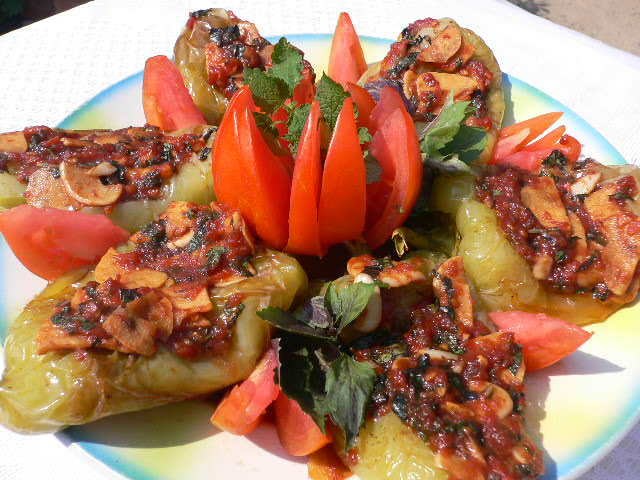Armenian Cuisine
Armenian cuisine is one of the oldest Asian ones and the oldest in South Caucasus. Its unique features have been shaped for thousands of years. Numerous national dishes involve time- and energy-consuming techniques.
Armenian cuisine is one of the oldest Asian ones and the oldest in South Caucasus. Its unique features have been shaped for thousands of years. Numerous national dishes involve time- and energy-consuming techniques. Minced meat and fish along with vegetables make the basis of Armenian cuisine.
Agants is an Armenian sweet dish. A certain ratio of wheat, raisins, nuts, and hemps is mixed together and covered with thick sugar syrup. Wheat grains are held in water for about an hour, drained and roasted in a hot pan without oil.
Aylazan. Slice eggplants and salt them; in 10 minutes, squeeze their juice out. Wash them and put into a frying pan or a saucepan. Add diced potatoes, carrot strips, sweet pepper, onions, peeled peas, sliced tomatoes, chopped herbs, add oil and salt; put another vegetable layer, add oil and several spoonfulls of water. Put a plate over the vegetables to press them, cover the pan and cook slowly till ready to serve. Ingredients: 500 g eggplant, 500 g potatoes, 2.5 onions, 4 tablespoons oil, 1-2 sweet peppers, 200 g peas, 5 tomatoes, herbs and salt to your taste.
Anushapur is broth with dried apricots.
Boraki is Armenian pelmeni. The dish is shaped to open cylinders in which the filling can be seen at the top. It largely resembles tumblers with filling in them. The usual way to cook them is by placing them tight in a saucepan, often in two rows. Minced meat for filling should be fried beforehand. Having placed the dish in the saucepan, Armenians add broth and butter and cook slowly for 15-20 minutes with the lid tight on the pan. When cooked, boraki should be taken out of the pan and fried in a frying pan. They are served with a sauce of matsun (fermented milk) and chopped garlic.
Yerevan bozbash. Cut mutton breast into pieces (40-50 gram each), pour water to cover the meat, and cook. When the water boils, remove the scum and cook for approximately an hour till ready; then take the meat out. Strain the broth, add peas, and cook. When the peas are soft, add potatoes cut into large pieces, apples, tomato pulp, sauteed onions, prunes, boiled meat, red pepper, and salt. Cook for another 10-15 minutes. Ingredients: 400 gram mutton:, ¾ glass peas, 250 g potatoes, 1 onion, 2 apples, 10 prunes, 1 tablespoon tomato pulp, ground red pepper and salt to your taste.
Karsi khorovats. Rinse mutton fillet, remove fat, cut into pieces, put into a ceramic or enamel pan. Add salt, pepper, dried vegetables, and finely chopped onions, sprinkle with vodka (or brandy) and lemon juice (or a solution of citric acid), and leave in a cold place. In 6-7 hours, thread the meat and broadtail fat on skewers and roast them vertically. Serve the meat and fat on a plate with sliced onions. Ingredients: 1.5 kg fatty mutton, 200 g broadtail fat, 500 g onions, ½ lemon or 2 tablespoons citric acid to your taste, 1 tablespoon brandy or vodka, salt, dried greens (dill, mint, cilantro, basil), ground red pepper to your taste.
Kyata is a traditional Armenian sweet dish shaped like large flaky flatbreads. There are about ten geographical variations. The difference lies in the exterior, placing of filling and crust, and the ratio of the basic ingredients (flour, eggs, butter, and sugar), while the principal composition and taste are similar, though there may be a difference in flavor (vanilla, cinnamon, cardamom). What makes kyata a special dish is the fact that the same ingredients used for its crust and filling, but the crust makes pastry, while the filling remains a paste of dry flour and powdered sugar mixed with butter.
Shahar lokum. Dissolve sugar in melted butter. Add egg yolk, sprinkle with brandy or vodka, and knead to make dough. Roll the dough into small round slices and bake in an oven. Ingredients: 500 g all-purpose flour, 200 g melted butter, 200 g granulated sugar, 1 egg yolk, about 50 g brandy or vodka.
Gata is sweet filled pastry served with tea or coffee.
Among meat products, preserved meat, tyal (Turkish kawurma) is of special significance. Well-cooked beef or mutton is put in a clay pot and covered with melted butter. The pot is sealed and stored in the cellar. Dairy products are also traditionally preserved for winter. Fermented milk, matsun (derived from matsunel, which means to coagulate), is the dairy staple of Armenian cuisine. Fermented milk is used to cook dairy soups, such as tanapur, spas, and many more.
Elyenora Amir
 Қысқа да нұсқа. Жазылыңыз telegram - ға
Қысқа да нұсқа. Жазылыңыз telegram - ға